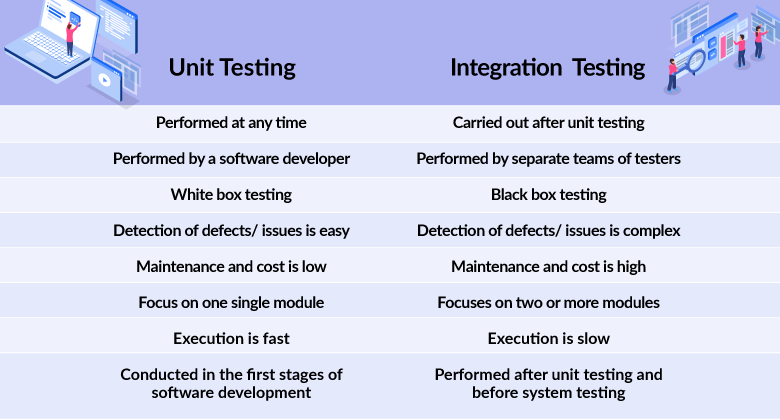Unit Testing:
In a manufacturing plant, unit testing is similar to testing individual components before they are integrated into a larger product. Each component (e.g., a microchip, a mechanical part, or a sub-assembly) is tested in isolation to ensure that it functions correctly and meets its specifications. Here's an example:
Imagine a car manufacturing plant. Before installing an engine into a car chassis, the engine itself undergoes unit testing. The engine is tested to ensure that it starts, runs smoothly, and meets specific performance criteria. The focus is solely on the engine, not how it integrates into the car.
Integration Testing:
Integration testing, on the other hand, is about testing how different components or subsystems work together when integrated into a larger system. It verifies that these components interact correctly, share data, and perform as expected when combined. In our car manufacturing example:
Once the engine is tested (unit tested) and deemed functional, it is integrated into the car chassis. Integration testing for the car involves starting the engine, testing brakes, lights, and ensuring that all these components work harmoniously when assembled. The focus is on how the engine integrates into the car and functions in the broader context.
In software development:
Unit Testing involves testing individual functions or methods in isolation to verify that they behave correctly. For instance, testing a specific mathematical operation or a database query function.
Integration Testing involves testing interactions between different parts of a software system to ensure that they work together as expected. For instance, testing how a web application's frontend interacts with its backend, a database, and external services.
In both manufacturing and software development, unit testing focuses on individual components or functions, while integration testing ensures that these components interact seamlessly when combined into a larger system. Both types of testing are essential to ensure overall system reliability and functionality.
Unit Testing
:
- Unit testing focuses on testing individual components or functions in isolation, ensuring that each unit of code behaves correctly.
- It verifies that each part of the code, like functions or methods, works as intended.
- In the context of Django, unit tests typically test views, models, and functions in isolation . Example: Unit testing for a registration function in Django (assuming you have a registration view or function):
unittest registration_tests.py
from django.test import TestCase
from django.urls import reverse
class RegistrationTestCase(TestCase):
def test_registration_form(self):
response = self.client.get(reverse('register')) # Replace 'register' with your registration URL name
self.assertEqual(response.status_code, 200)
def test_registration(self):
response = self.client.post(reverse('register'), {'username': 'testuser', 'password1': 'testpass', 'password2': 'testpass'})
self.assertEqual(response.status_code, 302)
self.assertRedirects(response, reverse('login'))
Testing a Math Function:
Purpose: Verify the correctness of an individual function.
Example:
# math_operations.py
def add(a, b):
return a + b
# test_math_operations.py
import unittest
from math_operations import add
class TestMathOperations(unittest.TestCase):
def test_add(self):
result = add(2, 3)
self.assertEqual(result, 5)
Testing a Django Model:
Purpose: Ensure that a Django model behaves correctly.
Example:
# models.py
from django.db import models
class Task(models.Model):
title = models.CharField(max_length=100)
completed = models.BooleanField(default=False)
# test_models.py
from django.test import TestCase
from .models import Task
class TaskModelTestCase(TestCase):
def test_task_creation(self):
task = Task.objects.create(title="Test Task")
self.assertEqual(task.title, "Test Task")
Integration Testing
:
- Integration testing verifies that different components or modules of your application work together as expected.
- It tests interactions between various parts of the system and ensures they integrate correctly.
- In the context of Django, integration tests may involve testing the interaction between views, models, and databases .# integration_tests.py
from django.test import TestCase
from django.urls import reverse
from django.contrib.auth.models import User
class RegistrationLoginIntegrationTestCase(TestCase):
def test_register_and_login(self):
# Register a user
response = self.client.post(reverse('register'), {'username': 'testuser', 'password1': 'testpass', 'password2': 'testpass'})
self.assertEqual(response.status_code, 302)
# Verify the user was created
self.assertTrue(User.objects.filter(username='testuser').exists())
# Login with the registered user
response = self.client.post(reverse('login'), {'username': 'testuser', 'password': 'testpass'})
self.assertEqual(response.status_code, 302)
self.assertRedirects(response, reverse('dashboard')) # Assuming successful login redirects to a dashboard
# Add more integration tests as needed
Testing a Django View Interaction:
Purpose: Validate that different components interact correctly within a Django application.
Example:
# views.py
from django.http import HttpResponse
def greet(request, name):
return HttpResponse(f"Hello, {name}!")
# test_views.py
from django.test import TestCase
from django.urls import reverse
class GreetViewTestCase(TestCase):
def test_greet_view(self):
response = self.client.get(reverse('greet', args=['Alice']))
self.assertEqual(response.status_code, 200)
self.assertContains(response, "Hello, Alice!")
Testing an API Endpoint Interaction:
Purpose: Validate interactions between your application and an external API.
Example:
# api_interaction.py
import requests
def fetch_user_data(user_id):
response = requests.get(f"https://api.example.com/user/{user_id}")
if response.status_code == 200:
return response.json()
return None
# test_api_interaction.py
import unittest
from unittest.mock import patch
from api_interaction import fetch_user_data
class TestAPIInteraction(unittest.TestCase):
@patch('api_interaction.requests.get')
def test_fetch_user_data(self, mock_get):
mock_get.return_value.status_code = 200
mock_get.return_value.json.return_value = {"name": "John"}
user_data = fetch_user_data(123)
self.assertEqual(user_data, {"name": "John"})
In these examples:
Unit testing focuses on testing isolated components or functions within your application, verifying their correctness.
Integration testing is concerned with validating interactions between different parts of your application, external services, or components. It ensures that they work together as expected.


Top comments (0)